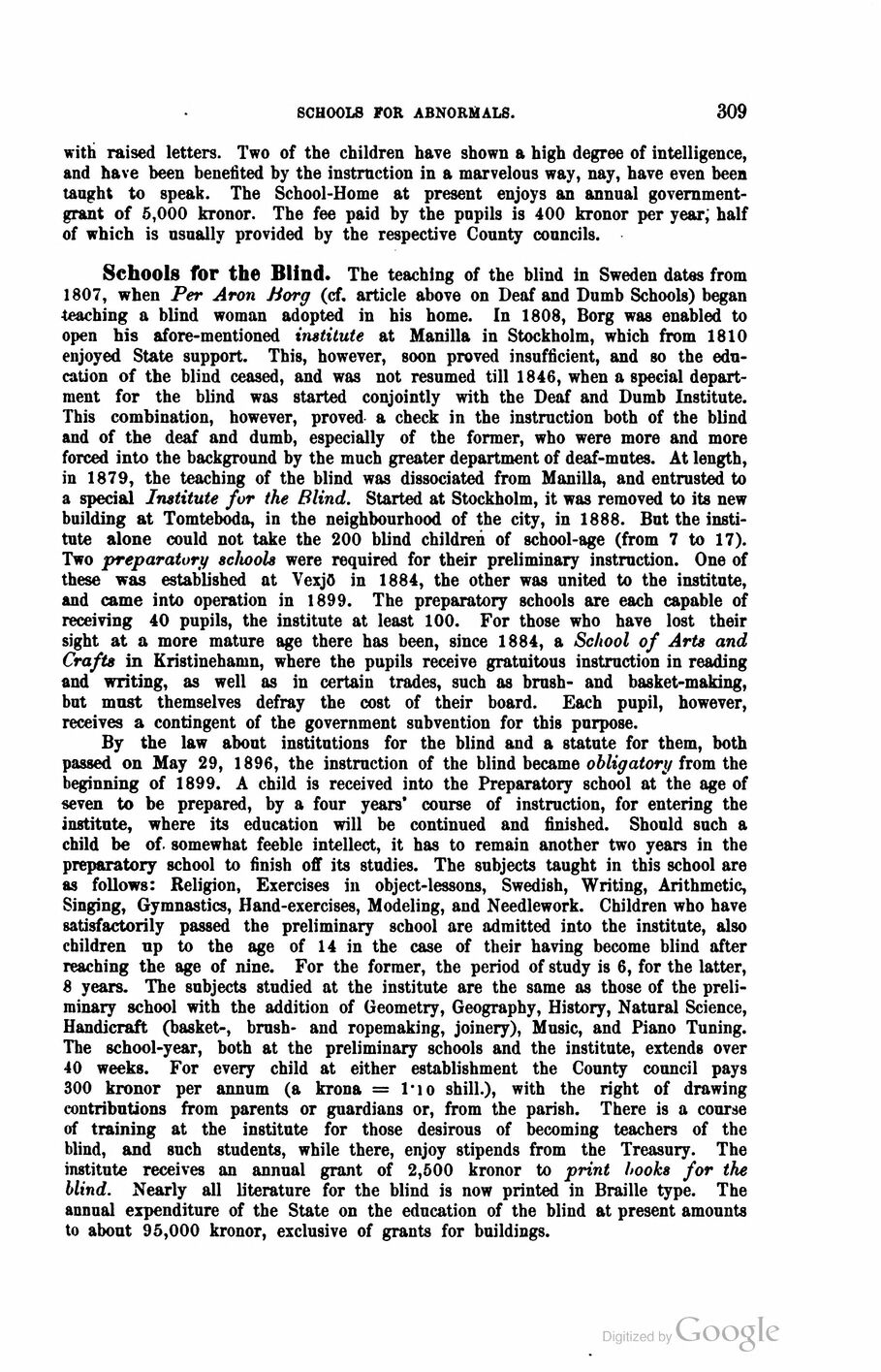
Full resolution (JPEG) - On this page / på denna sida - First part - IV. Education and Mental Culture - 1. Popular Education - Education of abnormals, and of neglected children - Schools for the Deaf and Dumb, by Fr. Nordin, Principal, Venersborg - Schools for the Blind, by G. A. Lyberg, Principal, Vexjö

<< prev. page << föreg. sida << >> nästa sida >> next page >>
Below is the raw OCR text
from the above scanned image.
Do you see an error? Proofread the page now!
Här nedan syns maskintolkade texten från faksimilbilden ovan.
Ser du något fel? Korrekturläs sidan nu!
This page has never been proofread. / Denna sida har aldrig korrekturlästs.
SCHOOLS FOR ABNORMALS.
309
with raised letters. Two of the children have shown a high degree of intelligence,
and have been benefited by the instruction in a marvelous way, nay, have even been
taught to speak. The School-Home at present enjoys an annual
government-grant of 5,000 kronor. The fee paid by the pupils is 400 kronor per year, half
of which is usually provided by the respective County councils.
Schools for the Blind. The teaching of the blind in Sweden dates from
1807, when Per Aron Borg (cf. article above on Deaf and Dumb Schools) began
teaching a blind woman adopted in his home. In 1808, Borg was enabled to
open his afore-mentioned institute at Manilla in Stockholm, which from 1810
enjoyed State support. This, however, soon proved insufficient, and so the
education of the blind ceased, and was not resumed till 1846, when a special
department for the blind was started conjointly with the Deaf and Dumb Institute.
This combination, however, proved a check in the instruction both of the blind
and of the deaf and dumb, especially of the former, who were more and more
forced into the background by the much greater department of deaf-mutes. At length,
in 1879, the teaching of the blind was dissociated from Manilla, and entrusted to
a special Institute for the Blind. Started at Stockholm, it was removed to its new
building at Tomteboda, in the neighbourhood of the city, in 1888. But the
institute alone could not take the 200 blind children of school-age (from 7 to 17).
Two preparatory schools were required for their preliminary instruction. One of
these was established at Vexjö in 1884, the other was united to the institute,
and came into operation in 1899. The preparatory schools are each capable of
receiving 40 pupils, the institute at least 100. For those who have lost their
sight at a more mature age there has been, since 1884, a School of Arts and
Crafts in Kristinehamn, where the pupils receive gratuitous instruction in reading
and writing, as well as in certain trades, such as brush- and basket-making,
but must themselves defray the cost of their board. Each pupil, however,
receives a contingent of the government subvention for this purpose.
By the law about institutions for the blind and a statute for them, both
passed on May 29, 1896, the instruction of the blind became obligatory from the
beginning of 1899. A child is received into the Preparatory school at the age of
seven to be prepared, by a four years’ course of instruction, for entering the
institute, where its education will be continued and finished. Should such a
child be of. somewhat feeble intellect, it has to remain another two years in the
preparatory school to finish off its studies. The subjects taught in this school are
as follows: Religion, Exercises in object-lessons, Swedish, Writing, Arithmetic,
Singing, Gymnastics, Hand-exercises, Modeling, and Needlework. Children who have
satisfactorily passed the preliminary school are admitted into the institute, also
children up to the age of 14 in the case of their having become blind after
reaching the age of nine. For the former, the period of study is 6, for the latter,
8 years. The subjects studied at the institute are the same as those of the
preliminary school with the addition of Geometry, Geography, History, Natural Science,
Handicraft (basket-, brush- and ropemaking, joinery), Music, and Piano Tuning.
The school-year, both at the preliminary schools and the institute, extends over
40 weeks. For every child at either establishment the County council pays
300 kronor per annum (a krona = imo shill.), with the right of drawing
contributions from parents or guardians or, from the parish. There is a course
of training at the institute for those desirous of becoming teachers of the
blind, and such students, while there, enjoy stipends from the Treasury. The
institute receives an annual grant of 2,500 kronor to print hooks for the
blind. Nearly all literature for the blind is now printed in Braille type. The
annual expenditure of the State on the education of the blind at present amounts
to about 95,000 kronor, exclusive of grants for buildings.
<< prev. page << föreg. sida << >> nästa sida >> next page >>